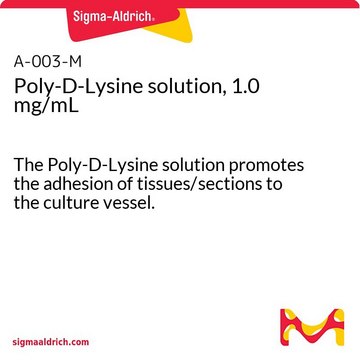P7280
Poly-ᴅ-Lysine Hydrobromide
synthetic, mol wt 30,000-70,000, powder, γ-irradiated, suitable for cell culture, BioXtra
Synonym(s):
PDL
About This Item
Recommended Products
product name
Poly-D-lysine hydrobromide, average mol wt 30,000-70,000, lyophilized powder, γ-irradiated, BioReagent, suitable for cell culture
biological source
synthetic (organic)
Quality Level
sterility
γ-irradiated
product line
BioReagent
BioXtra
form
lyophilized powder
mol wt
average mol wt 30,000-70,000
packaging
pkg of 5 X 5 mg
pkg of 5 mg
concentration
0.016—0.032 mmol lysine
technique(s)
cell culture | mammalian: suitable
surface coverage
4 μg/cm2
solubility
H2O: soluble 50 mg/mL, clear, colorless
shipped in
ambient
storage temp.
−20°C
SMILES string
O=C(C)[C@@](NC)([H])CCCCN.[Br]
InChI
1S/C6H14N2O2.BrH/c7-4-2-1-3-5(8)6(9)10;/h5H,1-4,7-8H2,(H,9,10);1H
InChI key
MEXAGTSTSPYCEP-UHFFFAOYSA-N
Looking for similar products? Visit Product Comparison Guide
General description
Application
- In coating tissue culture plate wells and coverslips for immunofluorescence microscopy of primary neuronal culture to study neurological disorders associated with Zika virus infection.
- To coat the coverslips for enhancing the attachment and proliferation of the myenteric cells isolated from the rat intestines.
- In preparing surface of coverslips for cell attachment for studying the myenteric plexus of rat’s small intestine.
This product is recommended as a cell culture substratum when using 0.5 - 1.0 mL of a 0.1 mg/mL solution to coat 25 cm2. Lower molecular weight versions of the product are less viscous, but high more molecular weight versions provide more attachment sites per molecule.
Biochem/physiol Actions
Features and Benefits
Components
Caution
Preparation Note
comparable product
Storage Class
11 - Combustible Solids
wgk_germany
WGK 3
flash_point_f
Not applicable
flash_point_c
Not applicable
ppe
Eyeshields, Gloves, type N95 (US)
Certificates of Analysis (COA)
Search for Certificates of Analysis (COA) by entering the products Lot/Batch Number. Lot and Batch Numbers can be found on a product’s label following the words ‘Lot’ or ‘Batch’.
Already Own This Product?
Find documentation for the products that you have recently purchased in the Document Library.
Customers Also Viewed
Articles
Poly-Lysine enhances electrostatic interaction between negatively-charged ions of the cell membrane and positively-charged surface ions of attachment factors on the culture surface. When adsorbed to the culture surface, it increases the number of positively-charged sites available for cell binding.
Cancer stem cell media, spheroid plates and cancer stem cell markers to culture and characterize CSC populations.
Extracellular matrix proteins such as laminin, collagen, and fibronectin can be used as cell attachment substrates in cell culture.
Protocols
Adhere cells to solid substrates using poly-lysine, which enhances electrostatic interaction between negatively charged ions of the cell membrane and the culture surface.
Our team of scientists has experience in all areas of research including Life Science, Material Science, Chemical Synthesis, Chromatography, Analytical and many others.
Contact Technical Service







